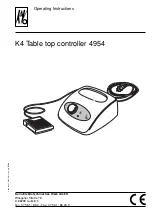
4-1
4
CARE AND CLEANING
The following are ArjoHuntleigh’s recommended daily and weekly cleaning and infection control procedures for
First Step Plus
while in use. If this product is to be purchased, or utilized for long term rentals, it is recommended
that manufacturer’s Infection Control Procedures be utilized by facility, dealership or home user. Contact local
manufacturer’s representative for details.
Carefully read
Contraindications, Risks and Precautions
and
Safety Tips
sections in the
Introduction
chapter
of this manual prior to performing care and cleaning procedures on
First Step Plus
.
Follow all regulations, outlined in OSHA Occupational Exposure to Bloodborne Pathogens 29 CFR 1910.1030,
regarding Infection Control Procedures to be used when cleaning
First Step
Plus
.
DAILY CARE AND CLEANING OF
FIRST STEP PLUS
WHILE IN USE
NOTE:
Patient does not need to be removed from First Step
Plus when performing daily cleaning procedures.
Patient may be bathed as patient support surface is being cleaned.
1.
Raise and lock Side Rails on both sides of bed, if decision has been made to use Side Rails. (Refer to
Risks
and Precautions
and
Safety Tips
sections in the
Introduction
chapter of this manual.)
2.
Inflate surface fully by adjusting all three air flow control knobs to their highest settings.
3.
If Side Rails are used, lower Side Rail only on caregiver side of bed.
4.
Log roll patient to opposite side of surface.
5.
Clean patient, as required.
NOTE:
Avoid spilling fluids on Air Supply Unit.
Fluids remaining on controls can cause corrosion, which may
cause components to fail or operate erratically, possibly producing potential hazards to patient and
caregiver.
6.
Wipe Cover Sheet, as required, with soap and water or approved hospital germicide.
7.
Move Cover Sheet for access and wipe soiled Mattress Overlay, as required.
Replace and launder
extensively soiled Cover Sheet or Mattress Overlay.
8.
Dry surface and Cover Sheet with towel. Remaining moisture will evaporate rapidly with air flow.
9.
Move Cover Sheet back into position.
10.
Move patient to clean, dry side of surface and repeat Steps 4 - 11 on opposite side.
11.
Return patient to center of surface.
12.
Return surface to previous air pressure settings.
WEEKLY CARE AND CLEANING OF
FIRST STEP
PLUS
WHILE IN USE
In addition to daily care and cleaning described above,
First Step Plus
Cover Sheet should be replaced weekly or
more often, as needed. Excessively soiled Mattress Overlay and Cover Sheet should be replaced and laundered,
as described in
Infection Control
section in the
Preparation for Use
chapter of the
First Step Plus
Maintenance
Manual
.
Summary of Contents for First Step Plus
Page 1: ...First Step Plus OPERATIONS MANUAL P N 200676 AH Rev A 09 2013 with people in mind ...
Page 4: ...ii ...
Page 19: ...6 2 ...




































